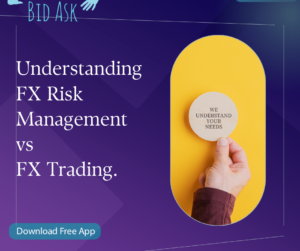Does FX risk management mean FX trading ?
In the vast expanse of the global financial market, Forex (FX) trading emerges as a pivotal player, orchestrating the dance of currencies across the globe. This intricate ballet of buying and selling currencies not only fuels international trade but also offers a spectrum of opportunities for investors and traders alike. Equally paramount, yet often less heralded, is the discipline of FX risk management – a strategic framework designed to navigate the turbulent waves of currency volatility. Together, these two facets intertwine, crafting a narrative that speaks of profit, peril, and prudence. This article embarks on a journey to unravel this complex relationship, exploring how the art of FX trading and the science of FX risk management converge, diverge, and ultimately, harmonize to form the backbone of the international financial market.

Forex trading, often referred to as FX trading, stands as a pivotal component of the international financial landscape. It involves the simultaneous buying of one currency while selling another, primarily for speculation, hedging, or trade facilitation. This dynamic market operates around the clock, distinguishing itself by its high liquidity and the vast volume of transactions.
The arena of FX trading is a melting pot, welcoming a wide array of market participants. At one end of the spectrum are individual retail traders, who navigate the market with nimble strategies and personal insights. At the other end are substantial entities like multinational corporations, banks, and hedge funds. These institutional players, with their substantial capital and strategic operations, contribute significantly to the market’s depth and liquidity.
A trader’s toolbox in the FX market is diverse, encompassing various strategies and instruments. Technical analysis stands out as a popular approach, where traders scrutinize charts and patterns to forecast future price movements. Leverage is another critical tool, allowing traders to amplify their market exposure with a relatively small capital outlay. Additionally, the strategic selection of currency pairs – each pair reflecting the economic dynamics between two nations – is a fundamental decision, shaping the potential risks and rewards of the trading journey.
While FX trading and FX risk management are intertwined in the currency markets, they serve distinctly different purposes. FX trading is primarily driven by the pursuit of profits through buying and selling currencies. Traders capitalize on market volatility, aiming to benefit from currency price fluctuations. In contrast, FX risk management is about safeguarding those potential gains and protecting the investment from adverse market shifts. It involves identifying potential risks, analyzing their impact, and employing strategies to mitigate them, ensuring that the volatile nature of the FX market doesn’t erode the trading capital.
Despite their differences, both disciplines are essential for a holistic approach to the currency markets. While FX trading leverages opportunities for wealth creation, FX risk management ensures that these opportunities are not compromised by unforeseen market turbulences. Together, they form a dual framework, empowering traders to pursue aggressive market strategies while shielding their investments from potential downturns.
In the intricate dance of currency markets, the harmonious relationship between FX trading and risk management cannot be overstated. It’s akin to a tightrope walker relying on a safety net; while the trader navigates the volatile FX market, effective risk management provides the assurance that mitigates potential falls. For instance, consider the tale of a seasoned trader who leveraged currency derivatives to hedge against an anticipated drop in the euro. When the drop occurred, the hedging strategy protected the trader’s portfolio from significant loss, turning a potentially disastrous situation into a controlled, calculated maneuver.
Incorporating a robust risk management plan is akin to setting the GPS before embarking on a journey; it guides trading decisions, signaling when to proceed, reroute, or halt. This strategic framework not only shields one’s capital from unforeseen market tumults but also fortifies the trader’s resolve by providing clarity amidst market noise.
Moreover, the advent of sophisticated technology and analytics has revolutionized both realms. Automated trading systems, armed with precision and speed, execute trades, capitalizing on fleeting market opportunities. Simultaneously, risk assessment tools diligently monitor market pulse, offering real-time insights and alerts. These technological advancements ensure that traders are equipped, not just with intuition and experience, but with a powerful arsenal of data-driven strategies, making the interplay between FX trading and risk management not just a balancing act, but a dynamic, informed, and strategic performance.
In conclusion, while FX trading and FX risk management serve distinct purposes within the currency market realm, their synergy is undeniable. FX trading seeks profit through astute market participation, whereas FX risk management focuses on safeguarding those potential gains against market unpredictability. A comprehensive grasp of both aspects is indispensable for individuals navigating the intricate landscape of FX markets. It’s this dual understanding that empowers traders to not only seize opportunities but also to shield their investments from unforeseen volatility, ensuring a balanced and informed approach to the dynamic world of foreign exchange.
